Improve Turn Behind Vs Push Barrel MLB Hands Above Level Bat Path Modern Swing For Baseball & Softball Hitting | Drills To Fix & Get Rid Of Bat Drag
Learn how to improve turn behind barrel vs push barrel MLB hands above level bat path in today’s modern swing for baseball and softball hitting. Discover drills to fix and get rid of bat drag once and for all.
Accelerate Barrel Rearward Like Mike Trout?
There are a few “gurus” out there promoting a rearward barrel acceleration, which I agree with but ONLY on pitches middle away/down in the zone. Teaching young hitters the concept over the past few years, with no disregard for pitch depth, some of my most clean mechanical hitters were having challenges getting to the inside pitch.
Rearward barrel acceleration is good, but MUST not be a blanket teach for all pitch depths. The best hitters, like Mike Trout, alter the timing of the barrel’s release off the back shoulder. Here’s a similar post I went in more depth on this concept with many examples.
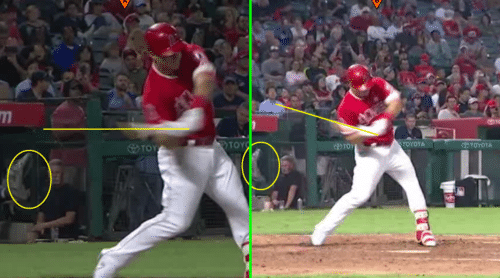
Mike Trout swing case study: hitting the “catcher’s glove”. Photo courtesy: MLB.com
Enter the softball drills content of this video. Here’s what I tried to do in the above Mike Trout swing case study:
- Select Mike Trout home-run swings that were based off similar pitch type, location, and pitch speed,
- Same game would assume same catcher and catcher’s position relative to the hitter,
- Same camera view, and preferably the same camera zoom setting,
- Comparing inner third of plate pitch location barrel path versus outer third, and
- Same pitcher would help control timing variable.
SCIENCE-BASED TRAINING:
Improve your hitting strategy dramatically by applying human movement principles.
Learn not only how and what to train but also the science behind the methods.
This was A LOT to ask, so truth be told…unfortunately, not all these points are affirmed in this case study. Let’s compare Mike Trout’s 200th and 201st career homers on September 29, 2017…
Pitch #1:
- Gonzalez was the pitcher
- 86-mph FB? outer third part of the plate, mid-thigh high
- Homer to LCF
Pitch #2:
- Vincent was the pitcher
- 90-mph FB, inner third of the plate, mid-thigh high
- Homer to LF
A softball drills note on Mike Trout’s “alligator arm” swing on Pitch #2:
- Okay if late on the inner half of the plate (purpose is to barrel up ball and that’s what Mike Trout is doing on pitch #2),
- NOT okay if doing off a tee, if on-time during soft-toss, or during dry swings (basically when timing is irrelevant or minimal), and
- CLICK HERE for a recent post on how to fix alligator arms, and how to practice what Mike Trout is doing with hitting the different “catcher’s gloves”.
- Fix Late Swings Fast: 2025 Pitch Recognition & See-Decide-Swing Training for Youth Baseball Power Hitters - October 6, 2025
- Safe Youth Weighted Bat Training: Proven Overload/Underload Drills to Increase Exit Velocity in Games Starting Tonight - September 29, 2025
- AI Coaching Course 2025: Youth Baseball & Softball Practice Plan + Off-Season & In-Season Workout Builder Fast - September 23, 2025

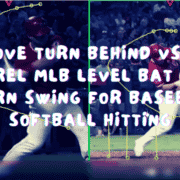
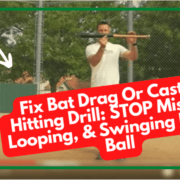
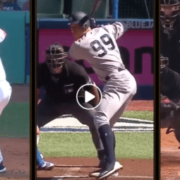

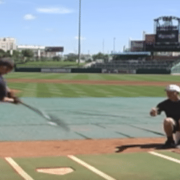

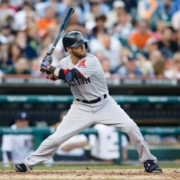





Joey,
Good stuff as always. I can’t argue with Mike Trout’s success. I can’t find fault with your conclusions about bat path either. However, I have a problem with his head position. Though he doesn’t quite violate Kelly Starrett’s “one-joint rule,” he almost does. He looks restricted, especially on the inside pitch. If hitting is a guess, as suggested by Perry Husband or hitting is a prediction as concluded by A. Terry Bahill and T. LaRitz in the Carnegie-Mellon study over 30 years ago, why does Trout put his head on his rear shoulder like that if he can’t see the ball hit the bat? Ted Williams said that he couldn’t see the ball hit the bat, how can Trout? He can’t. So, why the head movement?
Joe, love your comments. However, I’m not sure I agree that Mike Trout is in a bad “one-joint rule” position. He seems to keep similar distance between both ears and their respective shoulders at and post impact.
Joey, you are complicating this….The rearward movement is difficult if your not preset for it but the movement is a measuring movement and only done correctly if the batter has the correct approach…Your over complicating it…
~DM
To be honest, I don’t like the framing or the terminology of the so called “rearward movement”….
Not at all!!!! As an approach, the batter shouldn’t really think of going rearward….If you have the correct approach, you let it happen but only produced by the proper approach…
By the way, we are talking about barrel moving rearward….that just happens!!!!
Djura, the reality in teaching this is there are numerous young hitters casting the barrel too early…almost like an away approach. The problem is they do this on ALL pitch depths. Hence, the need to drill this.
Djura,
I don’t like the term. Some kids will think they just have to drop their barrel. It happens naturally if the sequence is set in motion properly. Front side shoulder, elbow, and hand must do their job, the rear shoulder, elbow, and hand must do theirs.
https://www.researchgate.net/profile/Silvio_Ionta/publication/6195817_The_influence_of_hands_posture_on_mental_rotation_of_hands_and_feet/links/09e4150a3a37e1932e000000/The-influence-of-hands-posture-on-mental-rotation-of-hands-and-feet.pdf?origin=publication_detail
Joey, look at this article…. it’s interesting… however I read some really interesting articles… if you want me to ever forward articles I find interesting I can… I would have at least two more that I think are really interesting….
This article I thought was interesting especially the last few lines and this visual thing…. One connection I made was when your presetting, it seems like your resisting and as thus you know where the movements are and it’s already an imprint in your mind….
~DM
Djura, great article. What I’d love is if you find a great article, please post and share a quick summary of what you got out of it. I’m reading and working on so many things right now, I don’t have as much time for other things. Thank you my friend, that would be a HUGE help.
Yea, Joe I’m not crazy about it too… but I’ll concede to Joey when teaching these methods but yes I’m not excited about it…
I do think that the early barrel movements and directions are good indicators that separate hitters …along with ball exit velocity….
And Joe, I think your right with the lead and rear parts… To get the mind right, at the end of your load… I usually teach that at that point the move will get explosive fast but so as long as you start with the inside part of your lead arm first, the batter is going in the right direction…and perhaps they will figure it out from there…
I actually put tape from the hands and stay inside to there armpit and even tap that whole area… and just make sure they know that’s the spark or fuse… that goes first FROM the end of the load…
To make it even more confusing, ill tape other parts too… Once they notice the moving parts it’s like magic….
Joey any thoughts…. Have you ever taped parts? Do you think it’s a good teaching method?
~DM
Djura, if the teaching method works, it’s effective. But may not work for all, but if you can find something that works for most, then you have a winner.
Joey,
I more than realize that it would be considered heresy to criticize Mike Trout nowadays since he is considered to be the best player in the game. However, his head movement looks awkward. His swing on that inside pitch looks forced. I don’t think that head movement is efficient. But, as you have said many times a hitter can be effective without being efficient. Does a great athlete like Trout succeed despite inefficient head movement as do J. D. Martinez, Kris Bryant, and Andrew McCuthcheon?
I think that Trout-like head movement is a product of the “Batting Tee Generation,” who were taught to put their head down and to the side in an attempt to see the ball hit the bat, which we both know is neurologically impossible. And Trout is attempting to see and hit 100+ fastballs yet. I find it interesting that you don’t see such Trout-like head movement with hitters from the past – Ruth, Williams, DiMaggio, Mantle, Maris, Mays, Aaron, Clemente, Bonds, Griffey Jr., just to name a few. Wonder why. Could it be that a lot of them (maybe with the exception of Bonds and Griffey Jr.) weren’t brought up hitting off tees?
Joe, maybe my standard is pretty low with one-joint rule…compare Bryce Harper to Trout…he makes Trout look like Mays!!! I don’t like what Arenado does either.
Djura,
I think that to use that cue wouldn’t be effective. If the sequence I described isn’t in place to cause the bat barrel to go rearward, a hitter would find it hard to do so, and likely just drop their barrel.
Great thoughts Joey. This stuff is hard to visualize this stuff in 2-D
What are your thoughts on the initial barrel direction from the landing/loaded position? I’ve been trying to feel that and I think the first direction the barrel moves is slightly different based on the location of the pitch. (The start of the barrel turn or swivel)
For the 3 locations you talk about:
– Outside: First barrel move is the flattest – most behind the head and toward 3b dugout for righty
– Inside: First barrel move is more toward the catcher even as far as the outside right shoulder of the catcher for a righty hitter.
– Middle: First barrel move right in the middle of those two locations.
Obviously these aren’t conscious moves in a live swing, but when I slow it down this is what I feel. I think the way the swing starts is how the plane is set and determines your ability to square it up.
The danger I see in working with younger players especially is that only that “middle” swing pattern gets worked on and grooved. And that plane doesn’t work with all pitch locations.
What’s your thoughts on this? I bring it up because I think it’s pretty closely related to what you’re explaining here.
Matt, right on! That’s another way of explaining it. I agree, I feel like most hitters are either taught to “swing down” (inside pitch approach), or deep barrel acceleration (outside pitch approach), but not taught the middle. That’s one thing I forgot to include in this post…when I throw LIVE or soft toss my hitters, then they default to middle approach and adjust from there. This is of course, they’ve done enough swings to feel each imaginary catcher’s glove. Making the conscious, unconscious.
Joey,
Don’t know how Bryce Harper does it. Nolan Arenado is almost as bad. Trout doesn’t go to that extreme. Kris Bryant (Got a kick out of his father saying that they patterned his swing after Ted Williams. Nowhere near Williams’ swing.) and J. D. Martinez almost do, though. I think Trout just looks a little forced. Seems he’s restricting himself. He got exposed up and in during the ALDS a few years back. I think he corrected it to an extent, likely lays off that pitch. Don’t get to see him enough since he’s on the West Coast. Like you have said many times – great athletes being effective without necessarily being efficient.
Yeah Joe I agree. However, even though some of these guys may have one chink in their armor, that’s about it. They made it to this level for a reason. The more chinks in the armor, the less likely they move up the ladder.
No!No!No!!!!!!
Everybody is complicating it…. Here I’ll fill you in…
Don’t think of the barrel. That is outside looking in…. Trust me…
You need palmer flexion of the lead hand where the knob of the bat is directed to the right of the ball… Than the knob or handle goes in a curve through the ball… Obviously if your holding your bottom 3 than your rear side just pops right through the ball because it has nowhere to go…
Said another way… it doesn’t matter where the the ball is because your palmer flexing to the right of the ball….
THE BARREL JUST KNOWS WHERE TO BE… perhaps after a little practice….
Your welcome!!!! And please cite your sources… like … some old stickball guy who grow up in Queens…. That will do….?
Joey, This is big as this leads to the scap row and I believe that when Hogan said he wanted 3 hands it’s specifically for the holding and than pushing the last part ONCE the the palmer flexion move gets the batter golfer to the the right of the ball…
Only if I was a mind reader…. but once you do this… it must be it!!!!!!And I just told you!!!!!
Hopefully we are starting from a protracted and depressed shoulder and…. with our pelvis tucked in with a short foot….
So yes your complicating it when looking at the barrel…. just feel the handle go to the right and through the ball back to the inside… where the handle goes the barrel follows… at the end of our load the lead forarm starts it…than and only than we should feel the bat in our forearms and the snap in our wrist and fingers…. From the elbows down should be built in with a purpose….
Good luck…
Please comment…
~DM
Djura,
I don’t disagree with you. It’s all a question of finding the right words to describe what is happening in the swing. Btw, what what is palmer flexion?
Seriously no comments!!!! Come on…
I know what I said is complicated and has to be understood in a vacuum with back knee action which compresses the lead side among many other actions…back shoulder row to a certain extent…etc…
But seriously nobody has any comments… Not even that it’s interesting…
You dont have to agree or disagree but at least let me know someone is at least reading my comments or perhaps considering them…
Hope all is well…
~DM
Joey,
I may have asked this question before but, the “hitting of the catcher’s glove” you advocate doesn’t involve changing the hand path to do so, does it? The hand path stays the same, correct? I see with Trout, in both cases, that he brings the barrel around his rear shoulder with the hand path the same
with a “palm up/palm down” approach, his front elbow positioning affecting barrel path. The barrel path for different locations is similar to the action of a flipper on a pinball machine. Would I be correct using that analogy?
I have a player who brings his hands diagonally down across the front of his rear shoulder. You’re not advocating that, are you? I have been trying to correct that.
Joe, the pinball analogy is a darn good one! It’s all based on swing intention. Whatever the hitter has to do to knock off the catcher’s glove in the proper pitch depth position.
Joey,
Not an original but I like that analogy.
Here we go discussing semantics again. Not sure I like the term, “swing intention” because, in my mind, it connotes a conscious effort. A hitter doesn’t consciously “intend” to swing a particular way, though he winds up doing so. It’s an unconscious reaction, the product of thousands and thousands of reps. Thanks for your response. Good stuff as always.
Joe, maybe I wasn’t clear in explaining swing intention…”intention” is the same as if I had an axe in my hand and went to chop down the tree. In that sense, I don’t care how mechanically I do it, I’m just going to chop down the tree…that’s intention. Hitters would use the same thing…I’m going to “compress the baseball”, “hit the ball as far as I can over there”, “knock the 2nd baseman’s hat off”…that’s what I mean with swing intention. Also known as external cueing.
Joey,
It’s been awhile. Hope all is well. In watching this Mike Trout video again, it’s about how long the barrel is actually on pitch plane. As you say in the video, the barrel enters the pitch plane earlier on an outside pitch and later on an inside pitch. But, how long is the barrel actually on pitch plane (in line with the incoming pitch), for an outside pitch and an inside pitch? My same question can be asked for different pitch heights.
Hey Joe!! Great hearing from you. I hope all is well over there on the east coast. To answer your question of how long is barrel on pitch plane…not as long as some might think. Old school people say get the barrel on plane early and keep it on plane for as long as possible. This IS NOT what the best do. And Chris Welch at Zenolink has data on this, if barrel is on plane too long, bat speed actually drops before contact. There’s a sweet spot, not too much and not much at all, we want the barrel on plane for the ‘just right’ amount of time. This video of Mike Trout demonstrates the difference.
Joey,
Thanks. All is well. Hope all is well with you. Yes, I think that we have another bad and confusing cue making the rounds. The barrel or “sweat spot” is not on plane very long, though both coaches and players say to get on plane early and stay on it as long as possible. It’s not the case. It is a when and where the barrel ACTUALLY gets on plane. Once again, words matter.
100% Joe!
Oh, do you have a link for the Zenolink study?
I do not. It was one of my online hitters awhile back. He physically went to Chris Welch’s place and got tested. It looks like ZenoLink is out by you: https://www.crunchbase.com/organization/zenolink …and it looks like it just a software application now.
Why change mechanics for an inside pitch? Why not just hit it earlier, i.e. in front of the front knee? Seems to me Trout was just a hair late on the inside pitch (given the higher EV) and adjusted by pulling in his front elbow to keep the barrel on it. So it appears to me it was a compensation rather than intention to have “alligator arms”. I swing with a somewhat barred arm and used to have hell with the inside pitch until i got a SwingAway trainer for my son, and the green felt mat that came with it shows you where to hit each pitch relative to home plate finally made it “click” for me. An inside pitch should be hit out in front of the lead knee, which wouldn’t require a different swing just an earlier one. Am i wrong in seeing that as an easier solution? FYI i tried your shorten swing path/hit the catchers glove drill with the three balls and i cant figure out what i am trying to do with my swing (almost feels like going back to a linear ground ball swing!). To hit the rear ball, i would be putting it in the 1B dugout. BTW I have read all your books, except the swing smarter, which i am working through now. I like your approach, and have been trying to teach it to my son (and eventually the rest of our 10u team).
Cory, hitting is 3-dimensional…pitch travels up and down (we say adjusting verticals), depth (we say adjusting horizontals), and timing (adjusting to velocity). You’re referring to the 2nd and 3rd. Our goal at HPL is to maintain high ball exit speeds no matter where the ball is in the zone. Mike Trout loses an average of 20-mph ball exit speed on down and away pitch versus up and in pitch. That’s about 80 feet of batted ball distance, almost the length of home to first. And he’s the top 1% of the top 1%. Do you know what mere mortals would lose using this same adjustable swing ‘chicken wing’ style? Lose 90-mph? 100? 120-mph?
When it comes to pitch depth and adjusting horizontals, there are two critical points to train: 1) When barrel enters zone, and 2) Contact point. Yes, we promote arm bar, but the question remains, how to get to the up and in pitch with an arm bar? By ‘swinging down’. Yes, you heard it right! Swinging down, getting on top of the ball, keeping barrel above the hands. These are feel cues, not actually what happens. What we used to think as the bad cues, are fantastic cues when it comes to middle in and middle up pitches. The closer the ball is to the hitter, the more extreme the swing down cue needs to be. Most likely you’re having a hard time with arm bar with inside pitch because you’re not swinging down enough.
My local and online hitters are smashing inside and up in the zone fastballs with this. They ARE NOT giving up 20-mph on the up and in pitch, probably not giving up 2-3 mph. In the Swing Smarter barrel path chapter, it will all become clear 😉